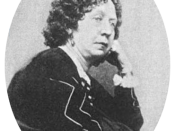#1 Southworth comments on women's lives and societies views in the novel The Hidden Hand. Southworth's humor is what made her novel so popular in the early nineteenth century. If Southworth had not used humor many people would not have read what she had to say about women. Two characters that the author uses to depict feminine stereotypes are Capitola and Clara Day.
Capitola, the young and adventurous spirit, crosses over many boundaries that many women did not have the chance to do in this certain time period. The first gender boundary that is crossed for the character of Capitola is when she dresses like a boy. "While all the ragged boys I know could get little jobs to earn bread, I, because I was a girl, was not allowed to carry a gentleman's parcel, or black his boots, or shovel the snow off a shopkeeper's pavement, or put in coal, or do anything I could just as well as they.
And so, because I was a girl, there seemed to be nothing but starvation or beggary before me. (40-41)" Capitola dressed as a boy in order to survive. Southworth allows the reader a glimpse as to how hard it was for a girl to survive yet how easy it was for a boy to survive. Capitola was very independent when women were supposed to be dependent either on their families or their significant others. This is shown through her riding without permission. Capitola was very brave and courageous when she jumped on Black Donald's back. Society viewed women as passive and Capitola was shown as the other extreme. While women were supposed to obey their family or husbands, Capitola ignores Old Hurricane many of times such as when she returns to the Hidden House.
Clara Day is the antithesis of Capitola in that she is very passive, obedient, and innocent. While men were sent for higher education, women were only allowed a certain amount of education. Clara Day came from a prominent family, yet only went to school until she was fourteen. Clara shows the stereotypical feminine obedience when she follows the court orders to go live with LeNoir and get married. Through Clara, the author provides the views of women in domesticated roles. When Clara came back from school, Marah Rocke was sent to teach her how to sew and care for the house. Women were supposed to be loyal and Clara showed her loyalty to her father and her husband.
The author uses Capitola's character to comment on the aspects of women's lives and to challenge society's views of women. Even though Capitola is the extreme of all of the characters, the author does not look down on the other characters. Instead, the other characters allow the reader to understand the absurdity in the roles that society has given women. Southworth uses the humorous Capitola to show how her actions aren't so manly. The only thing that the author believes that women could not do is overpower men physically. This is shown throughout the book when Capitola realizes that she cannot fight her way out but needs to outwit the villains. When LeNoir gave Capitola a bad name, she knew that she could not win strength-wise. Instead, Capitola outwitted LeNoir by shooting him with peas and making him confess to his wrongdoings. The point the author makes is that women are always going to be physically weaker than men but make it up by being clever. The author states that, "We prefer to look after our little domestic heroine, our brave little Cap, who when women have their rights, shall be a lieutenant - Colonel herself. Shall she not gentleman?" This is the closest the author comes to blatantly stating that women do not have many rights. Capitola is still domesticated in that she knows how to do needlework. The author still gave Cap a few distinguishing feminine roles and/or qualities to show that women could be adventurous and do things men do while still playing the female role. In conclusion, the author tries to imply that women can do anything that men do and possibly even better.
#2 Fanny Fern deals with a variety of topics and questions societies views. Some of these topics include wives, children, husbands, and marriage. Her sarcasm made her readings enjoyable to all and gave her the one of the highest ranks in woman journalism in the early nineteenth century.
In "The Flirt; or, The Unfaithful Lover," Fern speaks of a beautiful woman who was a sportsman in stealing the hearts of men and then dropping them. She was invited to a soon-to-be married couple's home in which she proceeded to steal the heart of an already taken man. The man ends up losing both women in the end. Women were not typically seen to be aggressive in nature. Women were supposed to be pure and Kitty was definitely not. Kitty is an extreme character that defies what society depicts a woman should be like. Women were considered to be loyal and passive. Nelly ends up leaving her unfaithful husband which was not very common in the early nineteenth century. Many women were so passive that they would let their husbands cheat and just turn their head. Fern ends the story with, "The moon looks on many brooks; the brook sees but one moon." The moon refers to men and the brook refers to women. While women were considered to just be happy that they had found a man and never look any further, men were seen to be unfaithful and that was socially accepted.
"A Practical Bluestocking" deals with societies views of women with intellect and women writers. A character claims that one of his friends is married to a woman writer and is embarrassed to go visit because he is sure that the house is dirty and she is very untidy. Fern comments on how society perceived women to be if they had jobs. They believed that women could not keep a household and a family if they worked. This character also defies society's beliefs by being a very clean and beautiful woman and also keeping a very tidy house. She does all of this while working and having a lovely relationship with her husband.
Fern focuses on the power of mother's intuition in "The Ballroom and the Nursery." A mother does not want to leave her house because she feels something terribly wrong is going to happen. The husband makes her go because he only cares about people seeing his beautiful possession. Of course the woman is passive and obeys her husband and while they are gone, the child dies. Society viewed women as a man's possession which is outlined through the acts of the husband in this story. The woman was very passive and obeyed her husband even though she knew something was wrong. The woman did exactly what society had expected her to do.
Fern uses a variety of perspectives to give you a glimpse into the lives and roles of women. In "The Flirt" and "A Practical Bluestocking," Fern goes beyond societies views and depicts women to be strong and powerful. Both women were strong and powerful in different ways. Nelly was strong in that she left her fiancé instead of giving in and staying with her unfaithful lover. The woman in "A Practical Bluestocking" was strong in that she worked and kept a good household. The woman in "The Ballroom and the Nursery" was opposite in that she obeyed her husband even though she knew that she should not go. All three short stories were written in a more serious tone in contrast to the many works of Fern that were done in sarcastic tones.





